#Smoking Pipe India
Photo

Quality glass pipes for the ones with glass love for clean and smooth experience.
BY THE BOOMBOX CLUB
2 notes
·
View notes
Text
Happy Trail India's Best Smoking Accessories Store
Happy Trail is India's online smoke shop where you’ll find fun, stylish designs that make smoking even more enjoyable than it already is. We’re the online head shop with unique pipes, glass bongs, waterpipes, dab rigs, smoking pipes, chillum, bubblers, and other accessories that match your personality and mood.
1 note
·
View note
Text
What Exactly Is Sannyo Smoking?

Well of course it sucks Mamizou, don't you remember what she said it's made of?

Now, an herb you can smoke that can grow on a mountain. The first, most obvious, initial guess would be marijuana. It's a weed after all, it can grow basically anywhere. Plus, let us be honest, it would be a little funny.
marijuana can definitely grow on mountains, it even grows on mountains in Central Asia

Plus, it is apparently spreading over northern Japan right now as a weed. They used to grow it for hemp material, not to smoke, it would probably not do much, but that wouldn't stop Sannyo if she wanted to give it a shot.
(Except I'm deliberately teasing)
There is a very, very obvious reason why it's not marijuana.
Marijuana has no nicotine, even though you can smoke it, it's not by any stretch of the imagination "tobacco"
Even if we imagine a world where this is the only thing Sannyo ever smoked, Mamizou smoked it with her and just said it was bad tobacco, not to mention Mamizou has recently been to the outside world and would probably know weed in seconds. (Which, although hypothetical, would have made for a hilarious Mamizou thought bubble)
We are looking for "tobacco" after all, we need nicotine, not just anything you can smoke, but it's a weed and a popular joke, so I obviously had to tease.

I could go through every variant of wild Nicotiana, tobacco was even imported to Japan by Portuguese sailors in 1542, and it's cultivation was legalized in 1625. The Hakurei barrier was formed in 1885, that's actually plenty of time for actual wild tobacco to spread.
But it might not work either.
While we might find some enthusiastic and previously cultivated tobacco growing as a weed that spread up to the mountains, it's not going to be unique enough. It'll be growing all over the place by the time it gets up a mountain. And the village would be smoking that exact same thing.
But most importantly, it's no fun.
Truth be told, there is a genus of Nicotiana that would work well in mountains, furthermore, Portugal actually had some at the time as an import from the Americas. But thats no fun, so I'll just return to this later when I inevitably run out of exotic options.
After all, if its tobacco made from "herbs" it would boarder on cheating to just use nicotiana, regardless of the form it ends up in.
Thankfully, there are other herbs and weeds beyond nicotiana that actually have nicotine, it really would be worthwhile check one of those.
And I've got a fun one. A whole family in fact.
Just above the Genus: "Nicotiana" is the Tribe: "Nicotianeae" and above that we find the family Solanaceae.
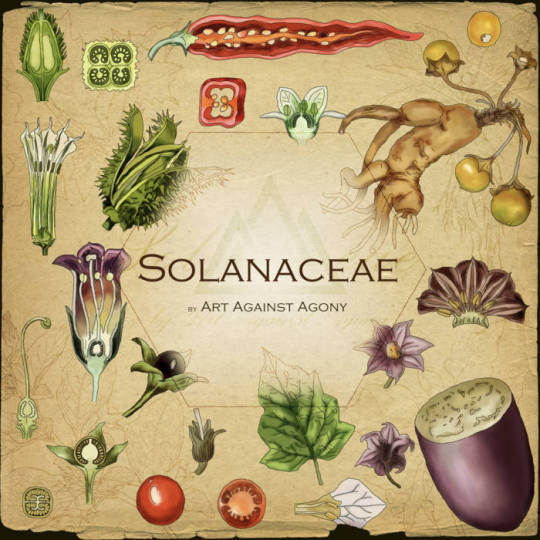
The Solanaceae, also known as the potato or deadly nightshade family
Nicotine is a naturally produced alkaloid in the nightshade family of plants
It contains everything from eggplants and other vegetables to the infamous Deadly Nightshade. (Atropa belladonna)
And of course, like I said, further down the family, it even has nicotiana itself. All of them contain nicotine to some greater or lesser extent. (Yes, hilariously even eggplants, a little bit)
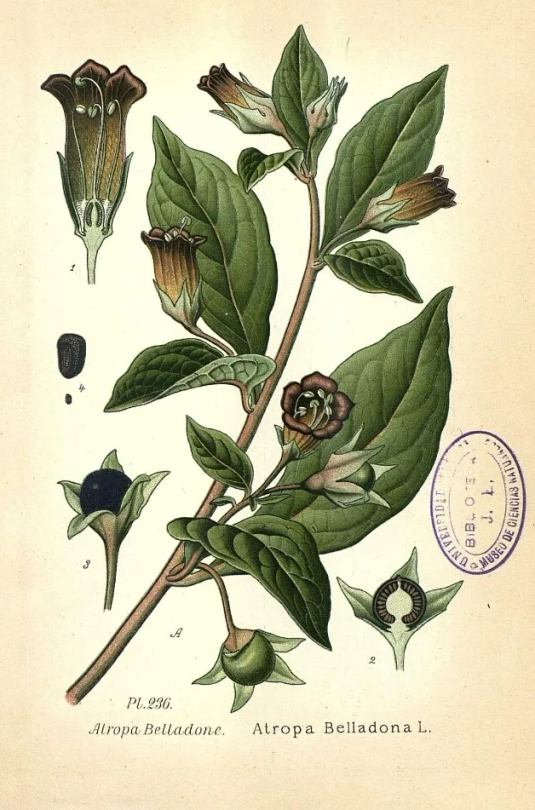
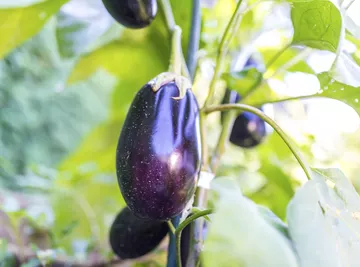
Solanaceae consists of about 98 genera and some 2,700 species. They grow naturally in more parts of the world than wild Nicotiana.
But we are just going to be looking through the nightshade variations, maybe some fruit, but no potatoes today. And these are coveniently famous for their narcotic effects.
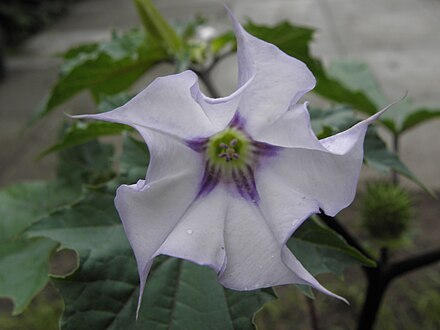
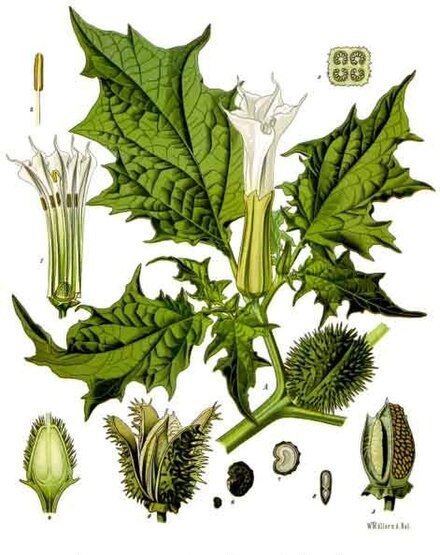
And some varieties, such as the Datura stramonium (occasionally called the Devil's Trumpet) had its leaves smoked in pipes and cigarettes, so much they were traded by the East India Company in the 18th century. And since it was popular for traditional medicine, some people might have even planted it.
But that type is not native to Japan, so it's got the same problem as the nicotiana. Not to mention, even though its an invasive weed, and can survive a little below the freezing point, in its current state, it probably doesn't like mountains. It probably wouldn't last a full winter on one.
This might be definite enough to just say it can be some hypothetical, wild, non specific variation of nightshade with the right combination of alkaloids and nicotine and presumably, relatively non deadly in the form Sannyo uses it.
Or maybe it is just better adapted to mountains form of imported of the Datura stramonium I just mentioned. I doubt even if it spread like a weed, that anyone but Sannyo would bother to figure out you can smoke that type of plant as tobacco.
But we are mostly just having fun at this point.
I doubt we could possibly think Zun cared up to this point, and definitely not beyond this point, we are just doing a fun overanalysis after all. Zun almost always seems to go for extinct species anyway, so it wouldn't be fun to follow that train of thought regardless..
[But if we just want a probable canonical answer Zun thought up. He might have just meant some non specific extinct variation of nightshade, since if there is at least one native version then that's enough to claim there could have once been others,
Besides, it's even possible zun just imagined she could possibly even mix her favorite flowers somehow, which while she probably could not, it would definitely be cute. ]
But we are going to take this further anyway to see if we can find something real and possible that currently exists today.
The simplest thing to think of native to Japan is just Japanese belladonna (Zun's proof of concept for an imaginary extinct nightshade if he really wanted a hypothetical one)
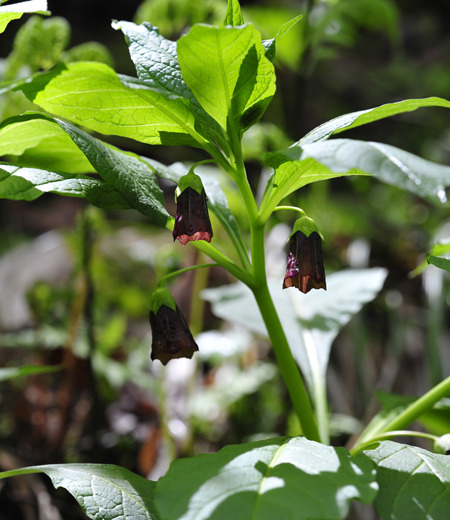
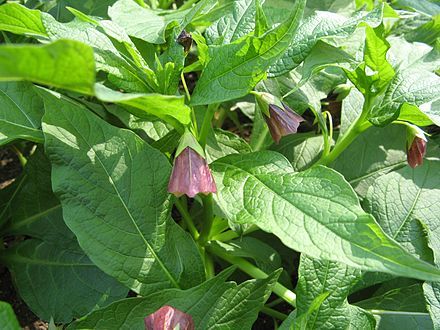
Scopolia japonica, also called Japanese belladonna. It's about as dangerous as the name implies. If eaten by mistake it can cause hallucinations. And while it no doubt contains at least some nicotine, it also contains the alkaloids Scopolamine
And more hilariously Hyoscyamine, known for helping the colon or bladder...
yes, you can use this extract to help you poop or pee if you want too.
Which is even funnier than the marijuana joke i made earlier.
And the only other species in the Scopolia genus is pretty similar and in Korea.
So we'll want to find something different.
But we are trapped. We only have imports left.
And the Datura genus we'd likely want is stuck in the Americas so we can only really consider a variety that came from those possible 18th century imports of Datura stramonium.


They are pretty perfect, tbh, spread widely to the Old World early where it has also become naturalized, and since it was already a weed that could endure dry climate and fairly cold environments. It could probably spread up a mountain.
They are our best bet for something you can smoke for recreation, with nicotine, outside the nicotiana genus that only Sannyo would use. If smoked people used its properties for recreation but you can also use it for anesthesia. Inject it's primary ingredient Atropine and you can use it for all sorts of weird stuff. (Though I pretty much resigned myself to having Atropine in the plant the moment I decided to run up and down the nightshade family).
Though in truth, she's probably just smoking wild tobacco that has lost a lot of flavor while struggling to adapt the mountain. So I'll move on to the most likely answer.
Portugal's more early tobacco is Nicotiana rustica, also called Aztec tobacco.
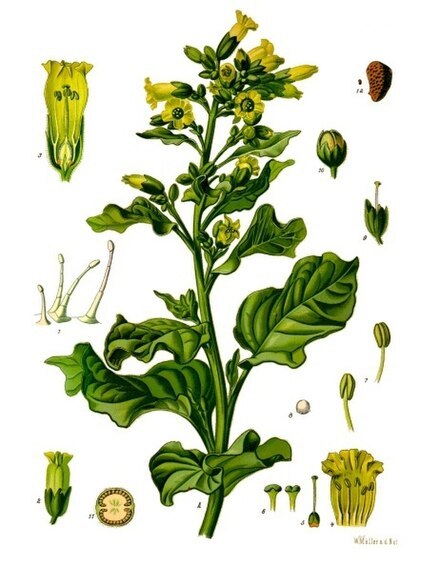
It is pretty tough and would probably adapt to a mountain pretty well.
I'd like to think it's the Datura stramonium since it's cooler and weird though.
In overview:
The simplest, best answer is just wild imported Aztec tobacco (Nicotiana rustica) from Portugal. Which had trade with Japan open up extremely early. Its honestly perfect for this

Followed by the more provocative option of Devil's Trumpet (Datura stramonium) imported later in the 18th century.

and the funny option. The only one actually native to Japan
Japanese belladonna (Scopolia japonica)

But it's almost definitely just that Aztec tobacco. (Nicotiana rustica)

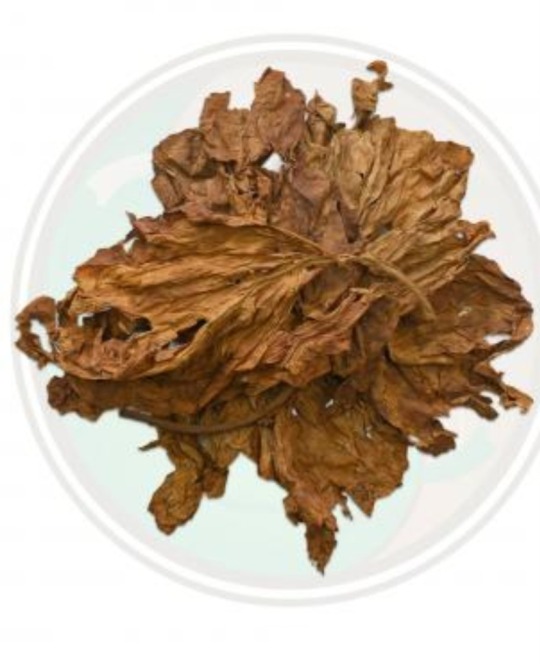
We could just imagine she mixes flowers or herbs into it to validate her "herbs" comment if we want (which again, would be cute)
#sannyo komakusa#touhou project#Flowers#Smoking#This took me collectively more than 16 hours#I had a ton of fun up until the point I realized Japan had like only one native option and was basically stuck with imports completely.#lotus eaters#It's probably just the Aztec tobacco but I felt obligated to run through looking for native nightshade#I'll need to make a short version later.#It's funny that I've imagined a world Sannyo would give smoking almost anything she comes across a shot if nicotine is involved.#mamizou futatsuiwa
34 notes
·
View notes
Text
For #NationalDolphinDay 🐬:
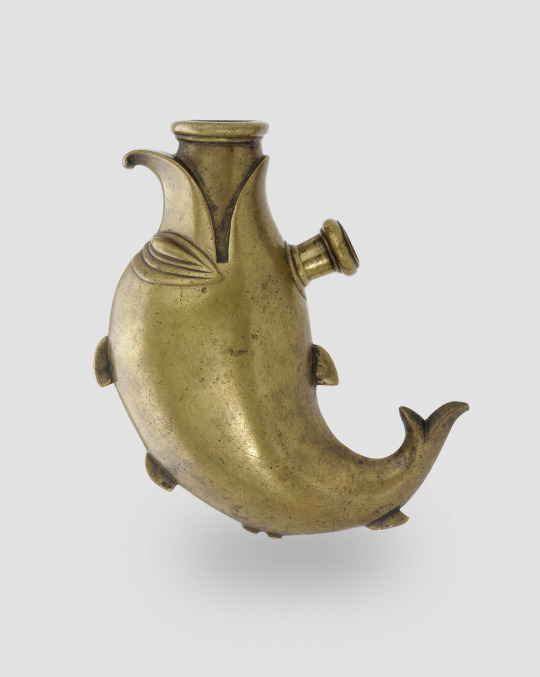
Hookah Base in the Shape of a Dolphin
Mughal India, 17th century
cast brass, 16.5 x 13cm
The Khalili Collections MTW 1500
“Smoking was introduced into the Mughal empire at the end of Akbar’s reign, when Asad Beg, one of his noblemen, brought tobacco and hookahs, or waterpipes, back from Bijapur in the Deccan. Asad Beg reported that tobacco was well known at Mecca and Medina and presented Akbar with a fine jewelled pipe with a mouthpiece of Yemeni carnelian. Although Akbar’s physician forbade him to smoke, the fashion for hookahs soon caught on and, as in Iran, various objects were adapted to hold the scented water through which the tobacco smoke passed. These included coconuts and various types of glass vessel, including bottles in which Dutch gin was exported, as well as spherical containers shaped like Indian waterpots [see MTW 1558]. These rested on rings or collars so that they stood upright. In addition, small hand-held hookah bases were made, some in the shape of mangoes or other fruit, or even in animal form and, as in this case, a dolphin.”
#animals in art#animal holiday#Islamic art#Mughal art#Indian art#South Asian art#Asian art#17th century art#brass#metalwork#hookah base#dolphin#National Dolphin Day#The Khalili Collections
10 notes
·
View notes
Text
THE MOORS
During the European Dark Ages, between the 7th and 14th century AD, the Moorish Empire in Spain became one of the world's finest civilizations. General Tarik and his Black Moorish army from Morocco, conquered Spain after a week-long battle with King Roderick in 711 AD. (The word tariff and the Rock of Gibraltar were named after him). They found that Europe, with the assistance of the Catholic Church, had returned almost to complete barbarism. The population was 90% illiterate and had lost all of the civilizing principles that were passed on by the ancient Greeks and Romans.

The Moors reintroduced mathematics, medicine, agriculture, and the physical sciences. Arabic figures including the zero and the decimal point replaced the clumsy Roman numerals. As Dr. Van Sertima says, "You can't do higher mathematics with Roman numerals." The Moors introduced agriculture to Europe including cotton, rice, sugar cane, dates, ginger, lemons, and strawberries. They also taught them how to store grain for up to 100 years and built underground grain silos. They established a world-famous silk industry in Spain. The Moorish achievement in hydraulic engineering was outstanding.
They constructed an aqueduct, that conveyed water from the mountains to the city through lead pipes from the mountains to the city. They taught them how to mine for minerals on a large scale, including copper, gold, silver, tin, lead, and aluminium. Spain soon became the world centre for high-quality sword blades and shields. Spain was eventually manufacturing up to 12,000 blades and shields per year. Spanish craft and woollen became world famous. The Moorish craftsman also produced world-class glass, pottery, vases, mosaics, and jewellery.
The Moors introduced to Europe paved, lighted streets with raised sidewalks for pedestrians, flanked by uninterrupted rows of buildings. Paved and lighted streets did not appear in London or Paris for centuries. They constructed thousands of public markets and mills in each city. Cordova alone had 5,000 of each. They were also introduced to Spain's underwear and bathing with soap. Their public baths numbered in the thousands when bathing in the rest of Europe was frowned upon as a diabolical custom to be avoided by all good Christians.
Poor hygiene contributed to the plagues in the rest of Europe. Moorish monarchs dwelled in sumptuous palaces while the crowned heads of England, France, and Germany lived in barns, lacking windows, toilets, and chimneys, with only a hole in the roof as the exit for smoke. Human waste material was thrown in the streets since no bathrooms were present. Education was made mandatory by the Moors, while 90% of Europe was illiterate, including the kings and queens. The Moors introduced public libraries to Europe with 600,000 books in Cordova alone. They established 17 outstanding universities in Spain.
Since Africa is a matriarchal society, women were also encouraged to devote themselves to serious study, and it was only in Spain that one could find female doctors, lawyers, and scientists. Moorish schoolteachers knew that the world was round and taught geography from a globe. They produced expert maps with all sea and land routes accurately located concerning latitude and longitude; while also introducing compasses to Europe.
They were such expert shipbuilders that they were able to use their geography expertise to import and export as far away as India and China. It was not by accident that a Moor named Pietro Olonzo Nino was the chief navigator for Christopher Columbus on the flagship Santa Maria.
He is said to have argued with Columbus as to who really discovered America. One of the worst mistakes the Moors made was to introduce gunpowder technology from China into Europe because their enemies adopted this weapon and used it to drive them out of Spain.
Europe then took the 700 years of civilization and education re-taught to them by the Moors and used this knowledge to attack Africa. While the Moors were re-civilizing Europe, great empires were thriving in Western Africa and frequently traded with the Moors.
These included the empires of Ghana, Mali, and Songhay, which prospered between 700 AD and 1600 AD. Africa was not a dark continent awaiting European civilization. In fact, Black African Egyptians and Black African Moors are credited with civilizing Europe."
18 notes
·
View notes
Text
Illicit methaqualone is one of the most commonly used recreational drugs in South Africa. Manufactured clandestinely, often in India, it comes in tablet form, but is smoked with marijuana. This method of ingestion is known as "white pipe".[20][21] It is popular elsewhere in Africa and in India.[21]
they still got ludes in south africa. also
The South African chemical weapons program investigated all the standard CW agents such as irritant riot control agents, lethal nerve agents and anticholinergic deliriants, which have been researched by virtually all countries that have carried out CW research. The South African program differed in its aims from the CBW programmes of many countries in that a major focus of the program was to develop nonlethal agents to help suppress internal dissent.[3]: 77–109 That led to the investigation of unusual nonlethal agents, including illicit recreational drugs such as phencyclidine (PCP), MDMA, methaqualone (quaaludes) and cocaine, as well as medicinal drugs such as diazepam (valium), midazolam, ketamine, suxamethonium and tubocurarine, as potential incapacitating agents. According to the testimony given by Wouter Basson to the Truth and Reconciliation Commission,[6] analogues of the compounds were prepared and studied, and both methaqualone and MDMA (along with the deliriant BZ) were manufactured in large quantities and successfully weaponised into a fine dust or aerosol form that could be released over a crowd as a potential riot control agent. Basson was later found to have also been selling large quantities of MDMA and methaqualone as tablets on the black market, but the amount manufactured was far larger than what was sold, and the court accepted that at least some genuine weaponisation and testing of the agents had been done.
14 notes
·
View notes
Text
Buy Glass Filter For Blunts Online In India
Glass filter for blunts are one of the most popular ways to smoke cannabis on the market today. The glass filter is a hollow tube that fits into your blunt, cigar or joint and acts as a screen for collecting ash and resin.
The main use of these filters is to keep your mouth from getting dirty from all the small particles that would normally fall into it when smoking without a filter. Many people prefer using glass filters because they don’t produce any smoke, so it’s easier on their lungs. Glass filters are also more convenient than rolling paper because they can be cleaned easily and reused over and over again.
There are many different types of glass filters available in many different sizes and shapes, which means you can find one that works best for whatever type of blunt you want to use it with. If you want something fancy, there are also colored ones available too!

The most popular type of glass filter is the one that fits into a joint or blunt; however, if you don’t have any blunts or joints or if you just want something more discrete then there are also options available for pipes!
The glass filter for blunts is made of high quality borosilicate glass. It has a metal ring on the top and bottom, to make it easier to load up your blunt with herbs. This glass filter is perfect for anyone who likes to smoke weed out of blunts. It filters out all of the nasty ash that can get into your mouth while smoking a joint or blunt, which makes smoking smoother and more enjoyable.
The Glass Filter For Blunts is also very easy to use. All you have to do is place it over the end of your cigarillo or joint, pack it with herbs, then light up! It's small enough to fit in any pocket or purse, so you can take it with you wherever you go!
Glass filter for blunts is the first of its kind, it is a glass that you can use to filter your blunt. The Glass Filter For Blunts will come in handy if you are trying to smoke your blunt with little or no ash on it. It also has the added benefit of preserving the taste and smell of your blunt. While some people may argue that this item isn't needed, others will argue that it is a must-have if you are trying to smoke weed.
Some people say that glass filter for blunts makes smoking weed more enjoyable because it allows them to have a more natural experience. If you have ever smoked from a bong before, then you know how much better this type of filter works compared to something like paper towels or other materials that will not be safe for your health.
The Glass Filter For Blunts allows you to inhale more of the THC content in your joint without having to worry about accidentally burning yourself on any hot ash left behind after smoking up your joint. That's why we recommend using one when preparing your weed joints so that you don't have to worry about burning yourself while smoking up!
3 notes
·
View notes
Text
History And Background Of Amanita Muscaria Mushrooms

Amanita Muscaria mushrooms are noted for their psychoactive properties, due to their containing the hallucinogenic chemicals ibotenic acid and muscimol. Also known as toadstools, these mushrooms have long been associated with magic in literature. The caterpillar in Alice in Wonderland is portrayed as sitting on one as he smokes his suspicious pipe, and in animated cartoons, Smurfs are seen to live in Amanita mushrooms. Of course, circles of mushrooms growing in the forest are frequently referred to as fairy rings.
It has been reported that as early as 2000 B.C. people in India and Iran were using for religious purposes a plant called Soma or Haoma. A Hindu religious hymn, the Rig Veda also refers to the plant, Soma, although it is not specifically identified. It is believed this plant was the Amanita Muscaria mushroom, a theory popularized in the book "Soma: Divine Mushroom of Immortality" by R. Gordon Wasson. Other authors have argued that the manna from heaven mentioned in the Bible is actually a reference to magic mushrooms. Images of mushrooms have been identified in cave drawings dated to 3500 B.C.
In the church of Plaincourault Abbey in Indre, France is a fresco painted in 1291 A.D. of Adam and Eve standing on either side of the tree of knowledge of good and evil. A serpent is entwined around the tree, which looks unmistakably like a cluster of Amanita Muscaria mushrooms. Could it be true that the apple from the Garden of Eden may actually have been an hallucinogenic mushroom?
Siberian shamans are said to have ingested Amanita Muscaria for the purpose of reaching a state of ecstasy so they could perform both physical and spiritual healing. Viking warriors reportedly used the mushroom during the heat of battle so they could go into a rage and perform otherwise impossible deeds.
In the Kamchatka peninsula of Russia the medicinal use of Amanita Muscaria topically to treat arthritis has also been reported anecdotally. L. Lewin, author of "Phantastica: Narcotic and Stimulating Drugs: Their Use and Abuse" (Kegan Paul, 1931) wrote that the fly-agaric was in great demand by the Siberian tribes of northeast Asia, and tribes who lived in areas where the mushroom grew would trade them with tribes who lived where it could not be found. In one occasion one reindeer was traded for one mushroom.
It has been theorized that the toxicity of Amanitas Muscaria varies according to location and season, as well as how the mushrooms are dried. Click now organic magic shrooms
Finally, it should be noted that the author of this article does not in any way recommend, encourage nor endorse the consumption of Amanita Muscaria mushrooms. It is believed that the U.S. Food and Drug Administration lists Amanita Muscaria as a poison. Some companies that sell these mushrooms refer to them as "poisonous non-consumables."
3 notes
·
View notes
Photo

Madhabi Mukherjee and Soumitra Chatterjee in Charulata (Satyajit Ray, 1964)
Cast: Madhabi Mukherjee, Soumitra Chatterjee, Shailen Mukherjee, Shyamal Ghoshal, Gitali Roy. Screenplay: Satyajit Ray, based on a story by Rabindranath Tagore. Cinematography: Subrata Mitra. Production design: Bansi Chandragupta. Music: Satyajit Ray.
Charulata (Madhabi Mukherjee) is the beautiful, bored wife of the wealthy Bhupati (Shailen Mukherjee), who spends his time working on his newspaper devoted to the independence of India. At the start of the film, behind the opening credits, we watch as she embroiders a handkerchief for him, then Ray's ever-fluid camera follows her as she wanders through the richly appointed rooms of their house, gazing at the outside world through opera glasses and searching for something to read. At one point, Bhupati enters the house, smoking his pipe and reading a book, and walks right by her, not seeing or acknowledging her. But he becomes conscious of his wife's ennui and invites her brother, Umapada (Shyamal Ghoshal), and his wife, Manda (Gitali Roy), to live with them, and turns over the management of his business affairs to Umapada so Bhupati can devote more time to his newspaper. But Manda is empty-headed and prefers playing card games to providing intellectual companionship. Then Bhupati's cousin Amal (Soumitra Chatterjee), an aspiring writer, comes to visit, and Charulata is immediately attracted to him because of his literary interests and his sensitive poetic nature. In a scene set in the neglected garden of Bhupati's house, Amal writes poetry while Charulata soars on a swing, the camera tracking her movements. Their conversation inspires Charulata to express herself in writing, and she succeeds in getting a piece published about her memories of the village where she grew up -- even inspiring a little envy on Amal's part. Then we learn that Umapada has embezzled money from Bhupati and he and Manda have disappeared. Despondent, Bhupati tells Amal that he has lost trust in everyone but him, which stirs Amal's guilt: He realizes that he and Charulata have fallen in love, and rather than add to the burden of betrayal that has already been unloaded on Bhupati, he leaves suddenly. Charulata's grief at Amal's departure opens Bhupati's eyes to what has happened between his wife and his cousin. At the film's end, Charulata and Bhupati reach out for each other, but Ray chooses to depart from his usual mobile camera and to record the moment in a series of still photographs, over which he superimposes not the title of the film but that of the story by Rabindranath Tagore on which it was based: "The Broken Nest."
2 notes
·
View notes
Text
Glass Pipes Manufacturers in India

Welcome to OM Smoke World, your gateway to the finest Glass Pipes Manufacturers in India. If you're seeking premium-quality, exquisitely crafted glass pipes, look no further! Our carefully curated collection offers an extensive range of glass pipes designed to elevate your smoking experience. Read on to explore the expertise and artistry of India's top glass pipe manufacturers.
#glass pipes manufacturers in delhi#glasspipesmanufacturers#glass pipe manufacturers in india#om smoke world
0 notes
Text
Peacocks and Quetzals: Mughal/Aztec crossover fic
Razia took the long route through the orchard to avoid the palace courtyard. It was so noisy that evening, as all of Razia’s sisters and half-sisters were getting ready for the arrival of a young man who was supposed to be choosing his bride from among the princesses. His father was one of the most trusted and loyal guards of the emperor.
Razia wanted to slip away from the festivities and spend some time in the royal library, but she had to get there without being spotted. She leaned against a mango tree to catch her breath when a voice called out to her.
“Razia, don’t you want to meet Aziz? I heard he’s really handsome.”
Razia’s half-sister, Ayesha, appeared. Razia resented that Ayesha’s mother was married to the emperor, while Razia herself was the daughter of a concubine. The sight of Ayesha was breath-taking, for she wore a long silk sari and her hands were covered in intricate henna designs. Gold bangles adorned her forearms and her perfume smelled like rose petals. Razia had secretly always been jealous of how beautiful her least favourite half-sister was, with her shapely waist and her long legs. If Aziz was going to choose anyone, surely it would have to be her.
“I honestly don’t care. I need to go see Vimanam about something.”
“When are you going to stop talking to that old man? You’re going to have to get married soon. You’re not that ugly. Someone will take a liking to you. Definitely not Aziz, but maybe another man in his family who will be accompanying him today. You’ll never know if you don’t come,” Ayesha started lecturing “Besides,” she added with a mischievous flash in her sly green eyes “you wouldn’t want to miss my engagement today.” She was so confident Aziz would choose her!
“Why would anyone want to marry you? You’re so dumb!” Razia spat, and ran off. She knew Ayesha would not be able to run after her or her perfect hair might get ruined, but she could hear her screaming all kinds of insults back at her.
Razia was relieved to finally make it to the library. Talking to the court astrologer who spent his time there when he wasn’t advising her father always helped her to clear her mind. It was really Vimanam who had raised her, teaching her the fascinating stories of the Hindu gods. Her family was Muslim of course, but even though it ruled over India it knew better than to go against the dominant religion of the people. As a result, her father had no objections to appointing Hindus to important positions.
The feeling of being encircled by books lining every wall around her was comforting, and soon she found the elederly astrologer gazing at the stars from the library’s balcony. Razia approached him and bowed respectfully in greeting with her hands folded.
“Namaste, Guru Vimanam.”
Vimanam never minded if his deep thoughts were interrupted by Razia. He was a short man with dark skin and a huge potbelly. His hair and beard were silver. His voice was joyful and the corners of his eyes crinkled when he smiled.
“My child! It’s so good to see you on this auspicious night. But why aren’t you at the feast? I heard the young warrior Aziz is visiting.”
“You know I don’t care about that. It would’ve been so boring to stand there in a line of women, all with their heads covered by gossamer veils until he wanted to have a look at us. Then we’d recite some silly lines of Persian love poetry...”
“You’d have recited the best lines,” Vimanam joked.
“...And then Aziz would have to pick his bride and put a garland of flowers around her neck. It’s all just so stupid.”
“But aren’t you even the least bit curious to know who Aziz will choose?”
“It’s going to be Ayesha.”
The old astrologer couldn’t contain his laughter. He invited Razia to sit on the balcony and took out a pipe to smoke.
“You’re always welcome to talk to me anytime you need.”
Razia sat in silence for awhile as the astrologer puffed clouds of smoke from his pipe. “I see the Evening Star is out,” she observed.
“It is not a star at all but a planet, Venus. It’s almost the same size as earth.” Vimanam told her.
Razia was alarmed to hear this. “But how could it be that huge?”
“Because there are millions of worlds out there. Even the mightiest of kings is so insignificant in the grand scheme of things. We’re all controlled by the powers of the stars and planets that we are born under.”
“So you believe that everything that will happen is up there in the stars?” asked Razia.
“Our fate is written.”
“That’s unsettling. I’d like to be in charge of my own destiny. I want to see the world,” Razia said. “I want to travel to distant lands like Persia,Turkey and Greece someday. The idea of staying inside a palace for my whole life, caring for a nobleman’s children, feels like being imprisoned.”
“Some people are born to challenge fate. They can shape their own destinies. Today is a really special night, you know. The planets have aligned in such a way.”
Razia was lost in thought about her fantasy of exploring the world.
“Those white men from England who are always on the border of our empire who my father sometimes fights against and sometimes trades with, I want to know what their country is like,” she declared.
“Oh my goodness. That’s really, really far away.”
“I know. And then haven’t you wondered if there’s anything further away than that, beyond the Western Sea?”
“You’re crazy, Razia. There’s nothing beyond Europe. Ships have sailed that way and never returned.”
“You were just talking about other worlds in the sky. How has what I said sound any crazier than that?”
The old astrologer seemed to withdraw into a trance as he smoked. “Something wonderful that pushes the boundaries of space and time can occur today,” he mumbled.
Suddenly, Razia realized what he had been smoking this entire time and felt betrayed. She had respected him as a man with a vivid imagination and infinite wisdom, yet here was proof that he wasn’t as respectable as he seemed. She realized the source of his inspiration.
“That’s opium, isn’t it?” she asked.
“I swear I’m not addicted. It’s just for therapeutic reasons. You wouldn’t tell your father, right?”
Without warning, Razia snatched the pipe away from him.
“Wait! It’s a very strong dose. It’s not suitable for a girl!”
It was too late to stop Razia. She had already fallen into a deep, drug-induced slumber.
“Farewell, traveller,” he muttered. “Have a wonderful journey.”
She woke up in a field. It was full of tall, green plants that she had never seen before. They grew on stalks, and when she plucked one she noticed that they had silky husks on top and were filled with golden kernels. Where on earth was she? Everything about this land seemed so different from her home.
Razia noticed a girl approaching her with a concerned expression on her face, reaching out to give Razia a hand. The girl had high cheekbones, almond-shaped eyes and very straight, long hair. She looked very foreign. Razia graciously accepted her hand and was helped to her feet, but she could not understand anything the girl was saying. Razia had studied many languages at home, including Persian, Arabic, and Sanskrit, but this was a strange language that she had never heard before.
“What type of plants are these?” she tried to ask the girl, but the girl didn’t understand her either.
Razia had never been more confused in her life about what was going on, but she realized she was probably dreaming. If it was a lucid dream, she could understand anyone in her dream as long as she focused. She closed her eyes and struggled to understand the girl speak. Eventually, it made sense.
“My name is Quetzalli. Who are you? Are you okay? You look as though you’ve come a long way from a foreign land.”
“Yes, I’m fine. My name is Razia. I’ve come from beyond the sea.”
“You dress too well to be a Spaniard. Those are very fine clothes,” said Quetzalli, observing Razia’s blue sari.
“I’m not a Spaniard.”
“And you don’t look like the Moors the Spaniards bring with them.” Quetzalli added. Why did she talk about the Spaniards with such a hostile tone?
“Definitely not. I’ve got nothing to do with Spaniards.”
“Good. Then you’re welcome inside my home, until you can recover and go back to where you came from,” said Quetzalli. Razia noticed that the girl had a knife sheathed at her waist against her plain white dress. It was a glistening black colour, possibly made of obsidian. She’d never seen a knife forged from that material before. It looked very sharp and menacing. Had Quetzalli used it on Spaniards before?
Razia was lead to a small hut made of adobe bricks. She found it to be a charming little house as she was tired of the palace she had grown up in. Unfortunately, the floor of the house was covered in reed mats on which bodies rested.
“Careful not to step on the plague victims. I’m helping nurse the sick.”
It only took one look at the tortured faces of the people lying on the ground for Razia to figure out what illness they were suffering from. “Smallpox!” She cried.
“Oh, so you know about the disease? Tell me, is there a cure? None of the healers can figure out what to do.” Quetzalli explained.
“There is no cure. Only the strongest will survive,” Razia solemnly said.
“That’s exactly what I feared.” Sighed Quetzalli. She knelt by an old woman suffering from the disease and applied some cold rags to her patient’s forehead to try to bring down the fever.
Razia glanced at Quetzalli with a look of sympathy. She looked about two years younger than Razia, with a short, thin stature. Her dark eyes had a look of such profound misery in them. She soon learned why. As Quetzalli and Razia both drank something that Quetzalli called “chocolate”, which was very calming, Quetzalli explained the situation with the Spaniards.
“About five hundred of them arrived in Tenochtitlan a few months ago. There was a huge battle to get them to leave. My brother died in it.”
“I’m so sorry for your loss. I’m sure he fought bravely,” said Razia.
“Yes. I was really proud of him. He had the rank of Jaguar Warrior.” explained Quetzalli.
“Jaguar?”
“Oh, maybe they don’t exist in your country. They’re like really big cats.”
“So like tigers,” thought Razia.
Quetzalli took Razia for a walk out in the ruined streets of the once beautiful city of Tenochtitlan. Now there were so many corpses from smallpox victims in the canals of the city that it was hard to get by in a canoe.
“We thought we won when we drove them out of Mexico, but the disease was their weapon of mass destruction,” explained Quetzalli sadly. She sounded like she had nothing to live for anymore but to await her own death. Razia felt like she would feel the same way if the civilization of her people were so totally destroyed by outsiders.
Quetzalli had to buy medicinal herbs from the marketplace and then stop at the temple to pray, so Razia accompanied her. Quetzalli’s pet, a strange hairless dog with gray skin followed them. Razia was curious about the animals of this New World. She knew Quetzalli lived near a farm where they grew a plant called corn, but where did they keep the animals? Where were the cattle that helped them plough their fields? Where were the horses that helped them travel? Did they have elephants and camels too like her father’s stables contained?
Quetzalli told Razia that they did not raise any animals to be slaughtered or to help humans, apart from dogs and some strange chicken-like birds called turkeys.
“So the temple you are taking me to, it was made without the help of beasts of burden?”
“Well, we used slaves,” Quetzalli laughed.
“Oh,” Razia now understood. She found the Great Temple of Tenochtitlan to be an impressive monument. It had a pristine white colour and was topped by two shrines.
“One is to Huitzilopochtli, the god of war. The other one is to Tlaloc, god of rain.” Quetzalli explained.
“Your people have so many gods, just like the Hindus. Mine only have one.” Razia said.
“So it is like the religion of the Spaniards.”
A priest at the temple blew a conch shell to signal the start of the evening prayers. The priest’s headdress contained some beautiful green feathers.
“They’re from quetzal feathers. Very valuable,” said Quetzalli.
“They’re even nicer than peacock feathers,” said Razia.
“Do you know what the quetzal bird is like? It dies in captivity. It would rather die than live as a slave. People who catch quetzals must do so very carefully, and let the bird go as soon as its tail feathers are plucked.”
Razia was impressed by this explanation of the quetzal’s character. It was a bird with an inspiring personality. She was certain Quetzalli’s people were like this sacred green bird with long tail feathers. They would fight until the end and not live as slaves.
“That priest looks like a wise man with mystical powers,” said Razia.
“Our priests get visions by eating a type of mushroom,” explained Quetzalli.
As soon as Quetzalli said “mushrooms”, Razia knew exactly what she must do in order to wake up from this bizarre dream she was having.
A cannon ball struck the temple. The Spaniards were back, and this time with reinforcements.
“This city is doomed, Razia. You need to get out. Warn your people of the Europeans while you still can.”
From the dead body of the priest, Razia took a pouch full of magic mushrooms and ate them.
She found herself back at Vimanam’s library.
“The white men are very dangerous. Tell them to stay away.” She mumbled. The astrologer was nearby panicking.
“Razia! Oh thank goodness you’re finally awake. The British have laid siege to the palace.”
3 notes
·
View notes
Text
All About: Cannabis
History
- Cannabis probably originated in China. Medical and religious use can be traced to ancient China, India, Egypt and the Middle East.
- At the beginning of the 19th century, Napoleon’s soldiers brought cannabis to France from Egypt in the form of hashish.
- It became very popular with French writers and artists, who established Le Club des Hachichins (The Hashish-Eaters’ Club) in Paris.
Members included Theophile Gautier, Charles Baudelaire, Victor Hugo, Honore de Balzac, and Alexandre Dumas
- Hemp was grown in colonial America, but marijuana smoking probably came to the US with Mexican & Caribbean immigrants in the early 1900s.
- Cannabis (hemp) plant:
High THC content ---> Marijuana, recreational use
Low THC content (less than 0.3%) = industrial hemp
- In 1937, the Marijuana Tax Act instituted a national registration and taxation system aimed at discouraging all use of cannabis. It was overturned in 1969.
- Largely destroyed the hemp industry {note: this benefited paper manufacturers and thus indirectly benefited logging companies}
- United States Department of Agriculture lifted the tax on hemp cultivation during WWII
Legal Status
- In 1970, marijuana and THC became Schedule I illegal drugs.

2014 Farm Bill: permits cultivation of industrial hemp for research purposes
2018 Farm Bill: made industrial hemp legal, allowed CBD oil production
Preparation
- Marijuana is produced from flowering hemp (Cannabis sativa).
- Marijuana is a mixture of dried and crumbled leaves, small stems, and flowering tops.
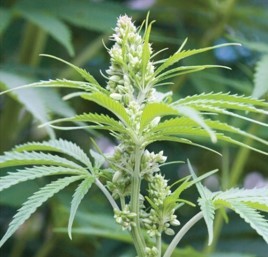
- Hemp seeds have been used for oil and bird food.
- It can be consumed orally, as in cookies or brownies, but is usually smoked in rolled cigarettes known as “joints,” various kinds of pipes, or in hollowed-out cigars called “blunts.”
- Hashish is a cannabis derivative that can be smoked or eaten.
- It can refer to a relatively pure resin preparation with very high cannabinoid content, or a solvent extract of leaves or resin.
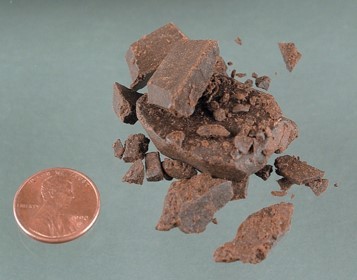
- Hash oil is an alcohol extract. A drop is placed on a tobacco or marijuana cigarette.
Ingredients
- Hemp contains 70 unique compounds known as cannabinoids, plus more than 400 other identified compounds.
- The psychoactive compound /_\9-tetrahydrocannabinol (THC) accounts for the use of cannabis as a drug. {note: that’s supposed to be a triangle; sorry}
- Marijuana potency (in terms of THC content) varies widely, depending on the genetic strain of the plant and growing conditions.
- Potency can be increased by preventing pollination and seed production by the female plants. This marijuana is called sinsemilla (”without seeds”).
- THC was identified as the major active ingredient in 1964.

- Burning marijuana causes the THC to vaporize and enter the smoker’s lungs in small particles.
- Effective dose and latency to onset of effects are influenced by the amount and potency of the plant used, and patterns of smoking (e.g. duration of held breath).
Administration & Absorption
Smoking
- Smoking marijuana is the quickest way to absorb THC, with blood levels peaking between 9-10 minutes into a smoke session.
- THC is easily absorbed by the lungs, and blood plasma levels rise quickly.
Edibles
- Thought to yield peak THC blood levels within 1-5 hours post-ingestion
- Poor absorption results in low and variable plasma levels, probably due to degradation in the stomach, first-pass metabolism.
Elimination
- Blood THC levels decline rapidly after smoking marijuana, but complete elimination from the body is much slower because of persistence in fat tissues.
- Half-life varies from a few hours to 3-4 days
- The gradual movement of THC metabolites back out of fat stores means that urine screening tests can detect them more than 2 weeks after a single incident of marijuana use.
Acute Behavioral Effects
- Effects of cannabinoid use vary depending on dose, frequency of use, characteristics of the user, and the setting in which use occurs.
- Subjective & behavioral effects of marijuana use can be separated into four stages: the “buzz,” the “high,” the stage of being “stoned,” and the “come-down.”
The “high” is associated with feelings of euphoria & exhilaration, and a sense of disinhibition.
Relaxation is the most commonly reported effect of being “stoned.”
- Smoking marijuana can sometimes produce transient psychotic symptoms such as depersonalization, derealization, agitation, and paranoia.
- Expectation also plays a role in what effects the drug will produce, as shown by placebo studies.
- Marijuana negatively affects cognitive functions.
Decreased performance for a variety of verbal, spatial, time estimation, and reaction time tasks has been noted.
Cannabinoids appear to interfere with all aspects of memory processing.
- Marijuana can affect psychomotor functioning under demanding task conditions, such as driving.
- Use of cannabis with or without alcohol is a risk factor in automobile accidents.
Acute Physiological Effects
- increased blood flow to the skin and flushing
- increased heart rate
- increased hunger
Chronic Behavioral Effects
- In young people amount of cannabis use is inversely related to educational performance.
- Some research supports the hypothesis that heavy cannabis use leads to persistent cognitive defects, impairing school performance.
- Alternatively, poor school performance and rejection of mainstream values (such as educational achievement) may increase cannabis use.
- Chronic cannabis use can also result in aimlessness, decreased motivation, lack of planning, and decreased productivity (amotivational syndrome).
{note: Amotivational syndrome can also be caused by SSRIs, and since there is a high rate of comorbidity between depression + anxiety, and between cannabis use + depression and/or anxiety, it can be difficult to determine whether SSRIs or cannabis are causing amotivational syndrome in patients who use both substances.}
- Heavy cannabis use over a long period may lead to impaired executive functioning for at least 2-3 weeks following cessation of use.
- Some data suggest that heavy, long-time users may continue to show impairment in decision-making, planning, and concept formation. It may negatively affect the prefrontal cortex.
- Imaging studies suggest that chronic marijuana use is associated with several kinds of abnormalities in the brain.
- Several studies have found a significant relationship between early heavy marijuana smoking and increased risk for later development of psychotic disorders such as schizophrenia.
Mechanisms of Action
- A cannabinoid receptor in the CNS was identified in 1988.
- Receptors occur in many brain areas.
- Localization of cannabinoid receptors in these areas is consistent with the behavioral effects of these compounds on locomotor activity, coordination, and memory.

- Endogenous neurotransmitter-like substances that act on the receptors = endocannabinoids.
- Two main endocannabinoids have been found: anandamide and 2-AG.

- They are retrograde messengers; they carry information in the opposite direction from normal (i.e. postsynaptic to presynaptic).
- THC similar to endocannabinoids binds to cannabinoid receptors located presynaptically on the nerve terminal. They are metabotropic: they work via G-proteins to inhibit presynaptic voltage-sensitive Ca2+ channels, and open K+ channels.
- As a result, cannabinoids decrease neurotransmitter release from the terminal.

Reinforcement
- In one study, regular marijuana users could discriminate THC-containing marijuana cigarettes from placebos with no THC, and all subjects preferred the marijuana with THC when given a choice.
- Animal studies have also demonstrated reinforcing properties.
Lever pressing by squirrel monkeys for THC stopped when placebos were used.

- Mechanisms for reinforcement:
Activation of the mesolimbic dopamine system: VTA --> NAcc
Interactions between the cannabinoid and opioid systems may play a role in cannabinoid reward and reinforcement; opioid agonists enhance cannabinoid self-administration, and opioid antagonists have the opposite effect.
Tolerance & Dependence
- Animals exposed to THC or other CB1 agonists develop tolerance to the behavioral and physiological effects of these compounds.
- It appears to involve a combination of desensitization and down-regulation of CB1 receptors.

Adverse Health Effects
- There are no reports of death from overdose.
- Smoking marijuana can damage lungs: smoke contains tar, other carcinogens, carbon monoxide, etc.
- Possible adverse cardiac effects?
- Immune system suppression
- THC may affect reproductive functions:
In AFAB people, it can affect ovulation.
In AMAB people, regular smoking has been shown to decrease testosterone levels and sperm counts.
Animal research has demonstrated pregnancy failure, delayed embryonic development, and even fetal death with THC administration.
Smoking marijuana during pregnancy results in cognitive deficits, poor school achievement, and increased risk for tobacco and/or marijuana use later in life.
DSM-5: Cannabis Use Disorder
- Marijuana use typically begins in adolescence and peaks during young adulthood.
- If an individual has not yet tried marijuana by their mid-twenties, they are unlikely to begin at a later age.

- Cannabis use varies based on demographics.
- Research shows college students and young adults most commonly use cannabis...
To socially conform (~40%)
To experiment (~30%)
For enjoyment (~20%)
To manage stress or relax (~10%)
- Risk of dependence is related to drug use patterns. People who progress to daily use have a 10-20% probability of becoming dependent.
- Dependence manifests as a difficulty in stopping one’s use, a craving for marijuana, and (in heavy users) unpleasant withdrawal symptoms:
irritability
increased anxiety
depressed mood
sleep disturbances
heightened aggression
decreased appetite
- These are similar to the symptoms of nicotine withdrawal.
Treatment
- Most cannabis users do not seek treatment.
- Treatment in outpatient programs involves cognitive-behavioral therapy, relapse prevention training, and/or motivational enhancement therapy, but patients are very vulnerable to relapse.
- Some research on medications to relieve withdrawal symptoms has been done.
Therapeutic Uses of Cannabinoids
- AKA “medical marijuana”
- Many states now permit legal use, but clinical studies of its efficacy have produced mixed results.
- Smoked marijuana has the highest potential for adverse health effects and abuse; most researchers favor development of cannabinoid-based drugs instead.
- Information from the National Institute of Health
- The FDA has not approved the cannabis plant for any medical use. However, the FDA has approved several drugs that contain individual cannabinoids:
Epidiolex, which contains a purified form of CBD derived from cannabis, was approved for the treatment of seizures associated with Lennox-Gastaut syndrome or Dravet syndrome, two rare and severe forms of epilepsy.
Marinol and Syndros, which contain dronabinol (synthetic THC) to treat nausea and vomiting caused by chemotherapy. Dronabinol is also used to treat loss of appetite and weight loss in people with HIV/AIDS.
- Endocannabinoids enhance the incentive motivational properties of food and food-mediated reward.
- CB1 receptor antagonists reduce food consumption in animals and human subjects.
- In animal studies, marijuana was shown to relieve anxiety and depression.
- There’s some evidence that marijuana might reduce addiction and/or overdoses caused by other drugs.
- Pain perception: transgenic mice that lack CB1 and CB2 receptors demonstrate hyperalgesia (increased pain sensitivity).
- Clinical evidence for cannabinoids as analgesics has not been convincing.
- Nabiximols (Sativex) is a cannabis extract.
was approved in the UK in 2010 to treat pain and spasticity in multiple sclerosis patients (not yet approved in the US)
- A number of years ago, Jamaican researchers prepared eye drops from cannabis extracts (trade name Canasol) for the purpose of reducing ocular pressure in glaucoma patients.
However, the research is inconclusive and Canasol was never licensed by the FDA for legal marketing in the United States.
4 notes
·
View notes
Text
Best Bongs and Smoking Pipes in India

Happy Trail have a great passion for craftsmanship and craftsmen and have a huge selection of premium smoking pipe, glass and water pipes, bongs, bubblers and dab rigs, as well as everything else available in India
We ensure that we hold these products up to our highest standards of quality and offer warranties for our most trusted suppliers and products.
We're also composed of a tightly group of glass enthusiasts committed to ensuring you receive the highest quality service and knowledge regarding the latest smoking equipment.
2 notes
·
View notes
Text
History And Background Of Amanita Muscaria Mushrooms

Amanita Muscaria mushrooms are noted for their psychoactive properties, due to their containing the hallucinogenic chemicals ibotenic acid and muscimol. Also known as toadstools, these mushrooms have long been associated with magic in literature. The caterpillar in Alice in Wonderland is portrayed as sitting on one as he smokes his suspicious pipe, and in animated cartoons, Smurfs are seen to live in Amanita mushrooms. Of course, circles of mushrooms growing in the forest are frequently referred to as fairy rings.
It has been reported that as early as 2000 B.C. people in India and Iran were using for religious purposes a plant called Soma or Haoma. A Hindu religious hymn, the Rig Veda also refers to the plant, Soma, although it is not specifically identified. It is believed this plant was the Amanita Muscaria mushroom, a theory popularized in the book "Soma: Divine Mushroom of Immortality" by R. Gordon Wasson. Other authors have argued that the manna from heaven mentioned in the Bible is actually a reference to magic mushrooms. Images of mushrooms have been identified in cave drawings dated to 3500 B.C.
In the church of Plaincourault Abbey in Indre, France is a fresco painted in 1291 A.D. of Adam and Eve standing on either side of the tree of knowledge of good and evil. A serpent is entwined around the tree, which looks unmistakably like a cluster of Amanita Muscaria mushrooms. Could it be true that the apple from the Garden of Eden may actually have been an hallucinogenic mushroom?
Siberian shamans are said to have ingested Amanita Muscaria for the purpose of reaching a state of ecstasy so they could perform both physical and spiritual healing. Viking warriors reportedly used the mushroom during the heat of battle so they could go into a rage and perform otherwise impossible deeds. Click now psychedelic mushrooms for sale
In the Kamchatka peninsula of Russia the medicinal use of Amanita Muscaria topically to treat arthritis has also been reported anecdotally. L. Lewin, author of "Phantastica: Narcotic and Stimulating Drugs: Their Use and Abuse" (Kegan Paul, 1931) wrote that the fly-agaric was in great demand by the Siberian tribes of northeast Asia, and tribes who lived in areas where the mushroom grew would trade them with tribes who lived where it could not be found. In one occasion one reindeer was traded for one mushroom.
2 notes
·
View notes
Text
THE MOORS By: Dr. Leroy Vaughn, MD, MBA. A Dynamic, Honest and Powerful View of Black History.
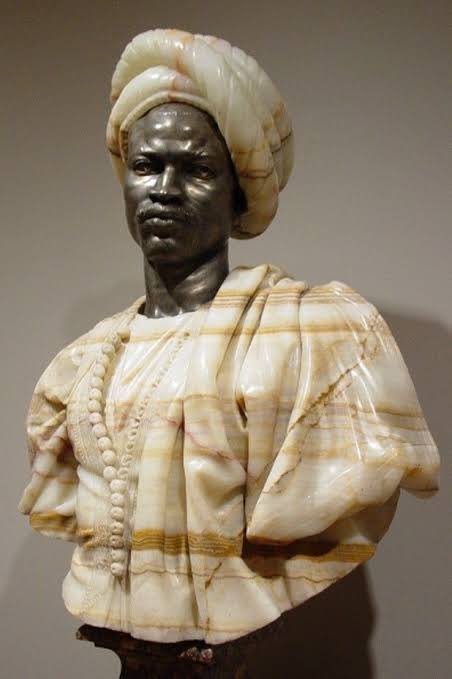
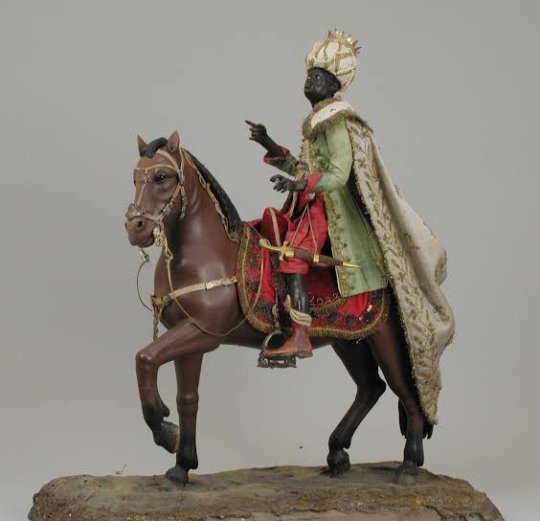
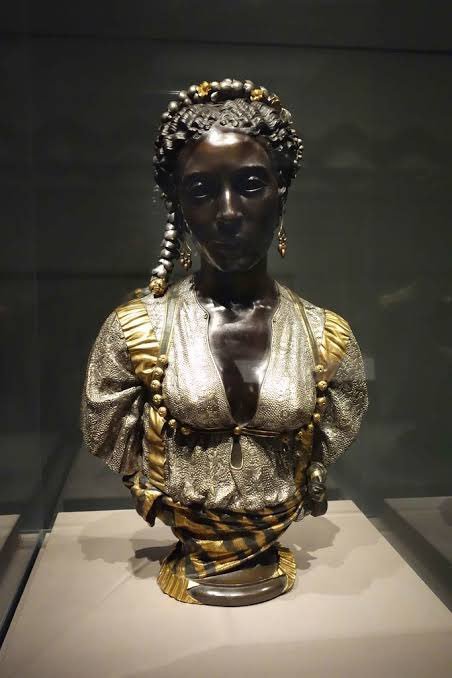

During the European Dark Ages, between the 7th and 14th century AD, the Moorish Empire in Spain became one of the world's finest civilizations. General Tarik and his Black Moorish army from Morocco, conquered Spain after a week-long battle with King Roderick in 711 AD. (The word tariff and the Rock of Gibraltar were named after him). They found that Europe, with the assistance of the Catholic Church, had returned almost to complete barbarism. The population was 90% illiterate and had lost all of the civilizing principles that were passed on by the ancient Greeks and Romans. The Moors reintroduced mathematics, medicine, agriculture, and the physical sciences. Arabic figures including the zero and the decimal point replaced the clumsy Roman numerals. As Dr. Van Sertima says, "You can't do higher mathematics with Roman numerals." The Moors introduced agriculture to Europe including cotton, rice, sugar cane, dates, ginger, lemons, and strawberries. They also taught them how to store grain for up to 100 years and built underground grain silos. They established a world-famous silk industry in Spain. The Moorish achievement in hydraulic engineering was outstanding. They constructed an aqueduct, that conveyed water from the mountains to the city through lead pipes from the mountains to the city. They taught them how to mine for minerals on a large scale, including copper, gold, silver, tin, lead, and aluminium. Spain soon became the world centre for high-quality sword blades and shields. Spain was eventually manufacturing up to 12,000 blades and shields per year. Spanish craft and woollen became world famous. The Moorish craftsman also produced world-class glass, pottery, vases, mosaics, and jewellery. The Moors introduced to Europe paved, lighted streets with raised sidewalks for pedestrians, flanked by uninterrupted rows of buildings. Paved and lighted streets did not appear in London or Paris for centuries. They constructed thousands of public markets and mills in each city. Cordova alone had 5,000 of each. They were also introduced to Spain's underwear and bathing with soap. Their public baths numbered in the thousands when bathing in the rest of Europe was frowned upon as a diabolical custom to be avoided by all good Christians. Poor hygiene contributed to the plagues in the rest of Europe. Moorish monarchs dwelled in sumptuous palaces while the crowned heads of England, France, and Germany lived in barns, lacking windows, toilets, and chimneys, with only a hole in the roof as the exit for smoke. Human waste material was thrown in the streets since no bathrooms were present. Education was made mandatory by the Moors, while 90% of Europe was illiterate, including the kings and queens. The Moors introduced public libraries to Europe with 600,000 books in Cordova alone. They established 17 outstanding universities in Spain. Since Africa is a matriarchal society, women were also encouraged to devote themselves to serious study, and it was only in Spain that one could find female doctors, lawyers, and scientists. Moorish schoolteachers knew that the world was round and taught geography from a globe. They produced expert maps with all sea and land routes accurately located with respect to latitude and longitude; while also introducing compasses to Europe. They were such expert shipbuilders that they were able to use their geography expertise to import and export as far away as India and China. It was not by accident that a Moor named Pietro Olonzo Nino was the chief navigator for Christopher Columbus on the flagship Santa Maria. He is said to have argued with Columbus as to who really discovered America. One of the worst mistakes the Moors made was to introduce gunpowder technology from China into Europe because their enemies adopted this weapon and used it to drive them out of Spain. #Africa
12 notes
·
View notes
